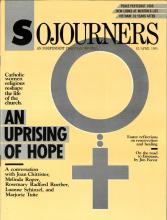The renewal of Roman Catholic religious life for women has taken many turns in the last 20 years. The lifestyle, governance models, prayer forms, formation criteria, and theology of the vows that directed the life of women religious in this century have all been scrutinized in an attempt to make the life both relevant to today's needs and faithful to the original inspiration of the order.
Changes have been widespread and critical. But it is not in these isolated pieces that the effects of renewal come into focus. It is in the ministries that now flow from religious life that the quality of renewal is most clear.
Nineteenth-century religious life was a common life of regulated behaviors and work that functioned to maintain the institution, but not necessarily to bring each woman to fullness of human growth and potential. Nevertheless, at the same time that nuns were being taught their functionalism, they were also getting a clear, if unconscious, awareness of their effectiveness as well.
Almost the entire social service network of the Catholic church in the United States was owned or operated by communities of women religious for more than 150 years, and was accountable to the church hierarchy, but most often operationally independent of it. With their own money and with their own personnel, women religious built and staffed most of the Catholic colleges, academies, hospitals, orphanages, and special-care facilities in the country.
Read the Full Article

